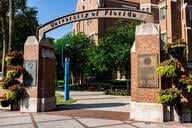You have /5 articles left.
Sign up for a free account or log in.
The common approach of colleges and universities during the coronavirus crisis is to continue instruction remotely. That is likely to fail.
This is not the first time that the education of young adults has been disrupted. World War II caused massive disruption for several years. The policies adopted then may work well now. Instead of trying to fruitlessly move countless classes online, we should adapt the GI Bill to a Coronavirus Student Bill.
The coronavirus crisis imposes great stress on hundreds of thousands, perhaps millions, of students. Many have had to leave their campuses. Some may have to worry about parents or grandparents falling ill. And some may have to take jobs instead of studying because their parents lost their jobs. In short, conditions for learning in the next months are poor.
Some people may claim that remote learning can be very effective. But we are not dealing with faculty members who want to teach remotely, who have had much experience with it or who have had time to develop courses. And we are not dealing with students who prefer online courses, who have had time to acquire proper computer equipment or who can ask their dorm roommate for assistance. So the experience of remote learning now upon us is likely to be worse that what we’ve previously seen.
Moreover, a fair amount of evidence suggests that, even under good conditions, online education does not offer the same quality of education that face-to-face classes do. David Figlio of Northwestern University and Mark Rush and Lu Yin of the University of Florida did an experiment where roughly 1,400 students were randomly assigned to either online or live lecture sections of a large introductory microeconomics class. The only difference was that some students viewed the lectures in person, while the online students viewed the videotaped lectures on the internet. The researchers found that the average test score was lower for the online students. Their study also showed that Hispanic students, male students and students with low ACT scores and GPAs did especially poorly.
A study by Spiros Protopsaltis, an associate professor and director of the Center for Education Policy and Evaluation at George Mason University, and Sandy Baum, a fellow in the Center on Education Data and Policy at the Urban Institute, found similar results: “On average, fully online coursework has contributed to increasing gaps in educational success across socioeconomic groups … Even when overall outcomes are similar for classroom and online courses, students with weak academic preparation and those from low-income and under-represented backgrounds consistently underperform in fully-online environments. Success rates are lower and employers -- in addition to students, faculty, academic leaders, and the public -- attribute lower value to online than to classroom degrees.”
And a National Bureau of Economic Research working paper, by scholars at Harvard University and Georgia Tech, also noted that various research studies have suggested that the online format generally leads to worse learning outcomes, particularly for academically weaker students.
So what should we do?
If many students won't get a good education in the coming months, it would be better to cancel the spring semester. Rather than pursue an educational approach that will most likely fail, we should then let students enroll in the fall, or whenever classes normally start again, with no tuition charged and living expenses also covered.
That’s what we did at the end of World War II, with the GI Bill of Rights (or Servicemen’s Readjustment Act of 1944), for all those veterans who could not attend college during the war. The federal government paid for both tuition and living expenses. In the peak year of 1947, veterans accounted for 49 percent of college admissions. And by the time the original GI Bill ended on July 25, 1956, 7.8 million of the 16 million World War II veterans had participated in an education or training program.
In a similar way, the U.S. Congress should pass a Coronavirus Student Bill, paying tuition and living expenses for one semester for all college students who were enrolled in college in March 2020. The cost? Total revenue of colleges and universities from tuition and auxiliary enterprises is about $200 billion a year, or $100 billion a semester. Not that big a number: it is only 6 percent of total student debt. And it is only a small fraction of the $2 trillion infrastructure bill House Democrats and the president are contemplating. Let’s invest in students.
Will students suffer from a delay in graduating? No. Probably the opposite. We are now probably in a recession, and the economy may very likely not recover by June when students graduate. Why subject them to years of lower earnings -- a situation that could, in fact, persist for some time if they enter the market during bad economic conditions? Hannes Schwandt and Till von Wachter studied the differential effects of initial economic conditions for labor market entrants in the United States from 1976 to 2015. They found persistent earnings and wage reductions, especially for less-advantaged entrants.
In sum, the evidence suggests that college students, suffering in so many ways from the coronavirus crisis, would benefit from canceling the current semester and instead getting an education -- and graduating -- during more normal times. And the federal government should help them afford to do that.




